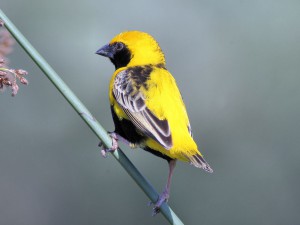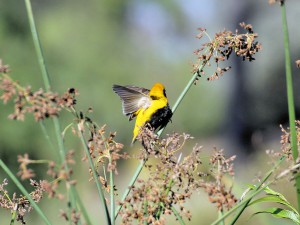A male Yellow-crowned Bishop (Euplectes afer) recently made news in Orange County. Part of what makes this unusual is that Yellow-crowned Bishop isn’t a wild bird. It undoubtedly is a released or escaped cage bird. Originally, Yellow-crowned Bishops come from Africa, and inhabit nearly every sub-Saharan country. So what’s all the fuss about? Well, for starters, he’s a cracking bird!
Where to Find Him
Moreover, this bird is just fun to watch! Present in San Diego Creek just upstream of Audubon House at San Joaquin Wildlife Sanctuary, this Yellow-crowned Bishop is very territorial. He perches high in clusters of sedge and aggressively chases virtually anything that comes near – Scaly-breasted Munias, Common Yellowthroats, House Finches… whatever! He doesn’t just chase them though; he puts on a show! First he puffs his feathers up and half opens his wings, about doubling in size. Then he launches at the intruders with rapid shallow wing beats looking like an angry little quail in hot pursuit. All the time, he utters a high-pitched, metallic, plinking call. His turf protected, he returns to his previous perch high in the sedge.
Almost any exotic escaped cage bird can become established in the southern United States. People who said the Pin-tailed Whydah would never become established in California are looking a bit foolish right now! You just never know.
At home in Africa, Yellow-crowned Bishops prefer grassland habitat, where they consume seeds. Typically, here in Orange County (generalizing from one bird – a dangerous ploy!) like the well-established Orange Bishop (Euplectes franciscanus), inhabits riparian or lakeside habitat, especially areas with full-grown sedge beds.
Description
The adult male Yellow-crowned Bishop is brilliant lemon yellow from his crown to his upper tail with a black face, throat, chest and belly, and a diffuse black collar on his nape. The median and greater coverts have broad white fringes on black centers, and his iris is a rusty. Generally, the much browner female Yellow-crowned Bishops show a streaky upper breast and a broad yellow-tinged supercilium that abuts an almost orangey lore. Occasionally, separating a female Yellow-crowned Bishop from an Orange Bishop might challenge beginning birders. Though with a good view, the two bishops are usually pretty distinctive. In any case, he’s well worth a view, at least until some Cooper’s Hawk picks him off!
These photos were digiscoped with a Canon EOS Rebel T3 DSLR attached to a Swarovski ATX-65 spotting scope using a Swarovski TLS APO adaptor.


